Bulletin – June 2019 Global Economy Spillovers to Australia from the Chinese Economy
- Download 847KB
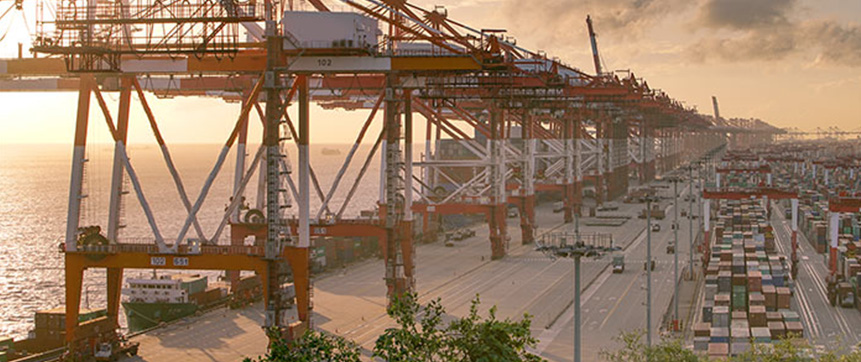
Abstract
China is Australia's largest trading partner. The strong links between the two economies raises the question of how a sizeable slowdown in Chinese activity would affect Australia. Through our research we have attempted to quantify how such a scenario could play out and its implications. We consider the main transmission channels, notably trade and financial market effects, and describe possible scenarios that could lead to a material slowing in China. We apply a stylised shock encapsulating features of these scenarios to a medium-sized macroeconometric model of the Australian economy and analyse how the shock is transmitted through real and financial channels. The potential for the exchange rate and monetary policy to offset some of those effects is also examined.
Introduction
Over the past decade, the Chinese economy has experienced growth averaging almost 8 per cent annually, underpinned by rapid urbanisation, industrialisation and increasing openness to world trade (Graph 1). The resource-intensive nature of China's development has meant that Australia's exports to China have expanded quickly over this period, driven by bulk commodities such as iron ore and coking coal. As a result, China has become Australia's largest trading partner, accounting for nearly one-third of Australia's exports, and around one-fifth of Australia's imports. Given the strong links between the two economies, the risk of a slowdown in China is often highlighted as a key uncertainty for Australia's economic outlook.
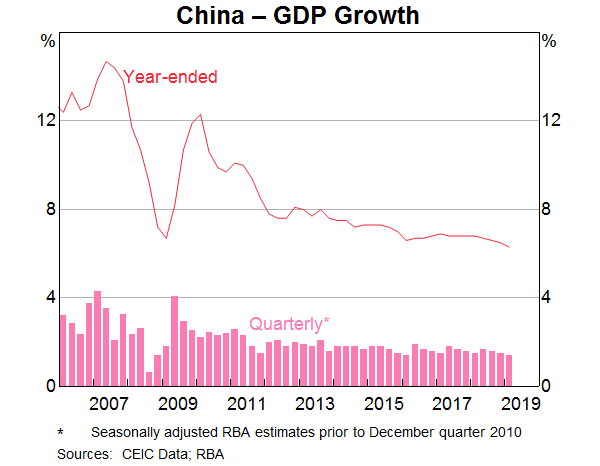
The pace and composition of China's growth has been changing. The sharp stimulus-driven increase in activity that occurred in the aftermath of the 2008–09 global financial crisis (GFC) was led by infrastructure investment and residential construction, funded largely by debt, which drove a surge in Australian commodity exports to China. However, this surge proved temporary. Since the early 2010s, growth has eased, accommodated by Chinese Government policies designed to put the economic trajectory on a more sustainable footing. Official statistics indicate that Chinese GDP growth declined from around 10 per cent in 2011 to 6.6 per cent in 2018. Over that period, the investment share of GDP declined from 45 per cent to 43 per cent, while the household consumption share rose from 36 per cent to 39 per cent (Graph 2).
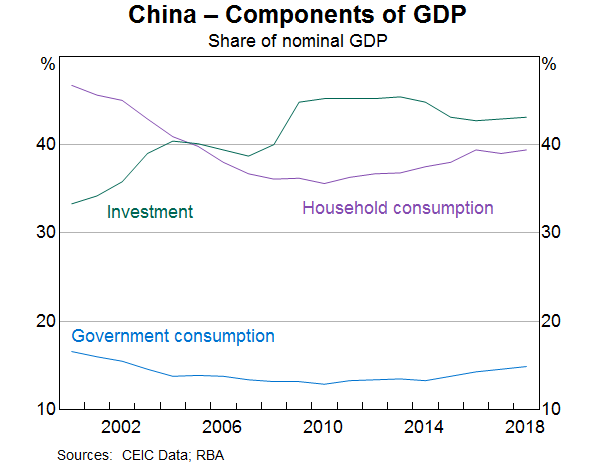
While Australia's exports of commodities to China have remained high, the nascent rebalancing of the Chinese economy towards a more consumption-driven pattern of growth is likely to weigh on resource exports in the longer term (Ma, Roberts and Kelly 2016, 2017; Roberts et al 2016). Nonetheless, changing patterns of Chinese demand are creating new opportunities for Australian exporters. Exports of services, especially education, have recorded double-digit growth in recent years and manufactured food exports (such as dairy products and food supplements) have expanded rapidly due to demand from China's growing legion of middle-class consumers.
The considerable exposure of the Australian economy to the pace and composition of growth in China raises the question of how the Australian economy would be affected by a substantial shock to Chinese growth. In recent years, Australian Government agencies and private sector analysts have repeatedly acknowledged the risk posed by a potential financial disruption, and related economic downturn, in China for the Australian economy (for example, see Australian Treasury 2018; RBA 2019). In this article, we attempt to quantify how such a scenario could play out in practice and its implications. The first section discusses key trade, investment and financial linkages between the Chinese and Australian economies that constitute the main channels through which a shock could be expected to spill over from one economy to the other. The second section considers how a large negative shock could plausibly occur in China and the possible forms it could take. The third section analyses the transmission of such a shock to the Australian economy through the lens of a medium-sized macroeconometric model of the Australian economy. We conclude with an assessment of how this exercise helps inform assessments of the risks that fluctuations in the growth of our largest trading partner pose to domestic conditions in Australia.
Main Channels of Transmission to Australia
A shock to the Chinese economy could affect Australia via a range of channels. Trade is likely to be the most significant channel given the strong direct trade links between Australia and China. In the event of a sharp slowdown in China, it is also likely that global commodity and financial markets would be affected, which could amplify the negative effects of a decline in export volumes. Of course, the exact nature of the slowdown in China would have ramifications for the size and nature of the spillovers to Australia.
Trade
Over the past decade, China has overtaken Japan as Australia's largest destination for exports, and has overtaken the United States to become Australia's second-largest source of imports (Graph 3). China's share of Australian exports has roughly tripled, and its share of imports roughly doubled, over this period. Since early in the current decade, China has steadily displaced all other major trading partners (MTPs) as a destination for Australian exports (Graph 4).
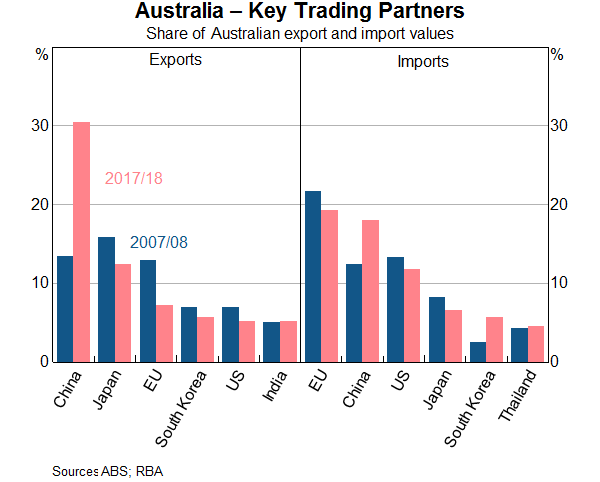
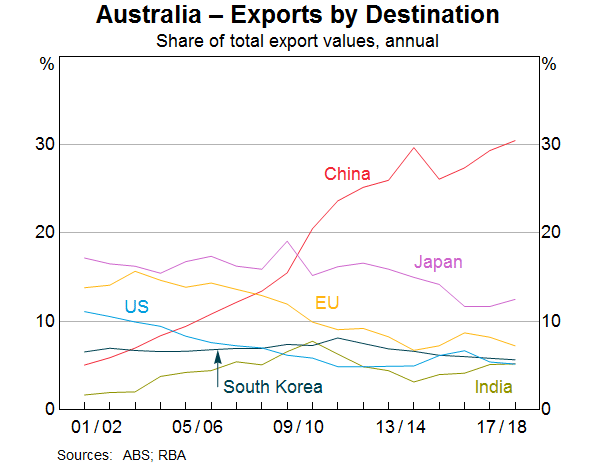
Resource exports continue to play an important role in Australia's strong trade links with China. Indeed, although iron ore export volumes to China have been relatively stable in recent years, they have remained at a high level (Graph 5). Meanwhile, exports of both coking and thermal coal have been rising. The continuing importance of resource commodities in bilateral trade between the two economies implies that Australia would be particularly susceptible to any easing in Chinese growth that led to a fall in steel production, and hence demand for imported iron ore and coking coal. Nevertheless, the fact that Australia is a low-cost supplier of iron ore and supplies a higher average quality of coking coal than can be mined domestically in China, may help to limit the impact (RBA 2014). Furthermore, Chinese demand for some other resources that Australia produces is less dominant. Overall, China accounts for around 40 per cent of Australia's resource exports.
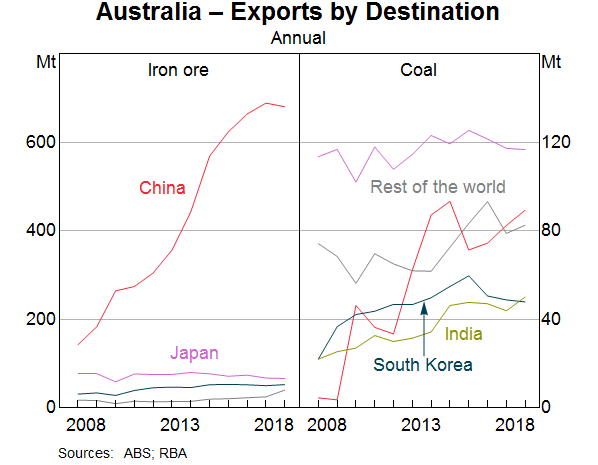
Other exports could also be affected materially by a negative shock to growth in China. Since the early 2010s, China has become the largest market for Australian service exports. Education and tourism services are the two largest categories of service exports to China, suggesting that Australia is likely to be vulnerable to a shock to the Chinese economy that causes a sizeable easing in household income growth (Graph 6). As noted above, China is also the largest destination for a range of other export categories (Graph 7). These include alcoholic beverages, such as wine; they also include food items, such as milk products, which make their way to China both via direct trade and more informal retail mail-order (‘daigou’) businesses. Furthermore, since a slowdown in activity in China is also likely to trigger an easing in activity in a range of other economies, the impact on the external sector is likely to extend well beyond the direct trade channels discussed above.
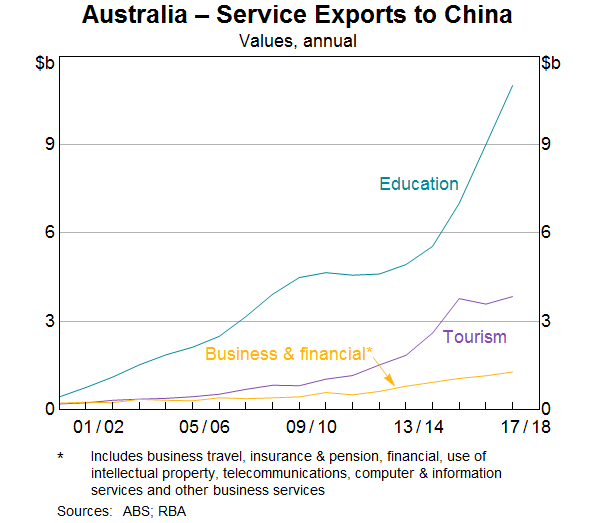
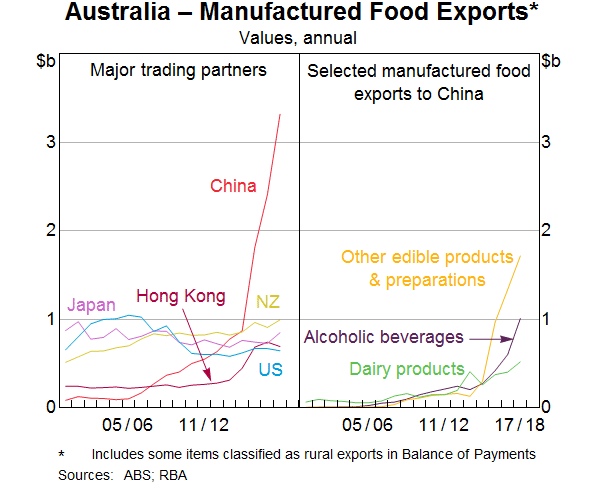
Global commodity and financial markets
China is a key source of demand in a number of major commodity markets and, as a consequence, a slowdown in economic activity in China could lead to sizeable falls in some commodity prices. Most relevant for Australia, China consumes almost half of the world's steel and is the largest consumer of its raw components – iron ore and coking coal (Graph 8). All else being equal, a surprise slowdown in Chinese economic growth would be likely to trigger a decline in the prices of these commodities, which in turn would weigh on Australia's terms of trade. In addition, as China is now the world's largest importer of oil, a slowdown in China is likely to weigh on oil prices (EIA 2018). Significant growth in exports of liquefied natural gas in recent years has seen Australia shift from being a net importer to a net exporter of oil-related products; therefore, a decline in the price of oil would also tend to reduce the terms of trade. Falls in commodity prices would have direct implications for mining revenues and investment, and indirect consequences for government revenue, shareholder profits and the demand for (and wages of) workers in the resources sector.

A substantial slowdown in Chinese economic growth could have a significant impact on global confidence and financial markets, especially equity prices, with implications for confidence and financial conditions in Australia. However, direct financial linkages between Australia and China are relatively small. Chinese direct investment in Australia accounted for only 4 per cent of the total flow of foreign direct investment into Australia in 2018. Meanwhile, at the end of 2018, Australian direct investment in China accounted for only around 2 per cent of the total stock of Australia's direct investment abroad. Australia's exposure to China via banking links is also fairly limited (Graph 9). While banking exposures have increased significantly from a very small base over the past decade, in 2018, only 4 per cent of the total international exposure of Australian-owned banks related to China. There has been a rise in lending by Chinese banks in Australia, which could be unwound in a Chinese slowdown scenario. Nonetheless, lending by Chinese banks still only accounts for around 4 per cent of all business loans issued and less than 1 per cent of all loans issued to households.
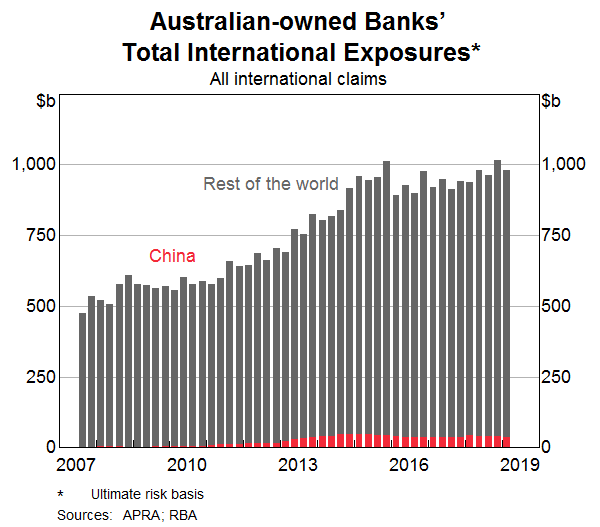
Potential Scenarios for a Sharper Economic Slowdown in China
As noted above, Chinese economic growth has been trending lower since the early 2010s as structural factors, such as a declining working age population, have weighed on growth. So far the slowdown has been fairly contained and most forecasters are predicting a further relatively modest decline in growth in the coming years. The consensus among private sector analysts is that growth will ease to 6.3 per cent in 2019 and 6.0 per cent by 2020. That said, there are a number of conceivable scenarios in which economic growth could slow much more sharply than this in the period ahead.
If a sharper slowdown in economic growth were to occur in China, it is likely that it would result from some combination of the following factors:
- Property market shock: As in many economies, property (and land) is a crucial component of the collateral base of the entire Chinese financial system. Residential construction activity also makes a significant contribution to economic growth. Eftimoski and McLoughlin (2019) estimate that, taking account of direct and indirect industry linkages, real estate investment contributed an average of 2.0 percentage points to annual real GDP growth between 2003 and 2017.
- External demand shock: While net exports were a small drag on Chinese GDP growth in 2018, the manufacturing export sector accounts for a significant amount of employment and has close linkages with a wide range of upstream sectors. Moreover, there is a precedent for the export sector to have a large effect on growth in the event of a sharp decline in foreign demand. Following the sharp decline in external demand associated with the GFC, net exports reduced Chinese GDP growth by 4.0 percentage points and 1.3 percentage points in 2009 and 2010.
- Policy coordination issues: As economic activity has continued to moderate in China, authorities have emphasised that they will not resort to the magnitude of fiscal and monetary easing introduced during the GFC and that policy will remain fairly targeted. Such an approach allows the authorities to continue to implement ‘supply side’ policies aimed at making growth more sustainable by reducing debt and overcapacity (see Boulter 2018). But it does present the risk that, if the current measured policy easing proves ineffective, the slowing in GDP growth could accelerate before policy has time to react.
- Systemic financial disruption: China has relied heavily on investment, funded by debt, as an engine of growth. While effective at improving living standards over time, it has also generated additional risks for the economy. These risks stem not just from high debt levels, but also broader risks in the financial sector as a result of off-balance sheet lending and concerns around the quality of some of the debt issued. The interconnectedness between the banking and shadow banking sectors means any shock could spread rapidly throughout the financial system.
While there is a broad range of potential triggers for a more severe slowdown in economic growth in China, in recent years authorities have proved capable of responding to individual episodes that posed systemic risk. For example, in mid 2015, the government managed to contain the fallout from sharp declines in the Chinese stock market, prompted by the collapse of sentiment among retail investors at the height of a leverage-fuelled speculative ‘bubble’ in the market. Similarly, in 2016 and 2017, authorities acted aggressively to tighten existing capital controls, impose new ones and increase their control over the renminbi to prevent capital flight and avert a much sharper currency depreciation (McCowage 2018). Over the past year or so, the government has strengthened regulatory oversight of the financial sector and taken steps to reduce shadow financing activity to reduce the risks of a future financial disruption or crisis. In light of all this, it seems most likely that a sharp slowdown in activity would occur in a scenario in which a number of these shocks coincide and authorities struggle to respond effectively to all shocks simultaneously. There are clearly many potential combinations of shocks that could lead to a notable slowdown in China; one illustrative scenario is sketched out below.
The success that authorities have had to date in preventing a collapse in property prices or a sudden stop in construction activity suggests that policymakers may well be able to avoid a sharp slowdown originating in the property sector. However, if weakness in property markets coincided, for example, with a pick-up in defaults on shadow banking loans that triggered widespread concern about the health of the financial system, the consequences would be harder for authorities to address. The resulting confidence effect could be expected, among other things, to weigh on equity prices and spur an increase in capital outflows, placing downward pressure on the exchange rate. While the currency depreciation would act as a buffer to domestic weakness, authorities might not be willing to allow that to occur, given their stated policy of maintaining currency stability.[1] In that event, policymakers would have limited capacity to respond to the slowdown with a monetary easing, at a time when local governments would already be facing a strain on their ability to raise funds as a result of reduced revenue from land sales due to falling property (and land) prices. In other words, authorities would encounter a scenario in which the economy is facing several headwinds at once but the presence of multiple policy objectives may limit their capacity to respond, increasing the chances of a sharp slowdown.
Macroeconomic Consequences of a Chinese Economic Slowdown for Australia
Quantifying the channels of transmission
To explore how a slowdown in Chinese economic conditions could influence the Australian economy, we conduct scenario analysis using MARTIN, the RBA's macroeconometric model.[2] Using a model allows us to quantify and trace through the implications of a change in overseas activity to domestic economic activity, and then from these variables to the labour market and prices. MARTIN accounts for interactions and feedback between all of these variables. Some financial market channels are also included, although banking-related channels are limited. We are able to include many of the channels described above, although most of these are captured as linear relationships and with differing levels of detail. A limitation of such macroeconometric models is that they are based on average historical relationships, and so may not encompass large movements in variables that have not occurred in the past.
As the starting point for the scenarios, we assume a 5 per cent fall in the level of Chinese GDP relative to current forecasts. This results in a trough in year-ended growth of 2 per cent, compared with a baseline forecast of around 6 per cent after the first year (Graph 10). Note that Chinese GDP growth is already expected to decline; the scenario represents a shock to the economy that sees a much sharper decline than forecast. This number is chosen to be illustrative of a pronounced slowdown and we do not assign a specific probability to such an event occurring.
The magnitude of the slowdown is smaller than what occurred during the GFC, but lasts a similar amount of time, with growth returning to its pre-crisis trend after two years. Even so, the level of Chinese GDP in the scenario is permanently below what it would have been in absence of the slowdown. We assume that Chinese policymakers respond to the slowdown with policy stimulus measures to prevent a more severe outcome. However, the resulting recovery in growth is somewhat less rapid than that observed during the GFC. This reflects the fact that, in responding to other policy objectives (such as deleveraging), Chinese policymakers may be more constrained in their ability to counteract a sharp fall in growth today than they were in the late 2000s. We do not examine how alternate triggers for a Chinese slowdown, or alternative paths for Chinese policy, would affect Australia differently. Instead, we assume a general slowdown that could arise from a combination of several shocks such as those described above.

We build three scenarios to illustrate the channels through which Chinese economic conditions could affect Australia, which we discuss in detail below (Figure 1).[3] First, we examine the effects of the slowdown through the trade and commodity market linkages between the two countries. As described above, these are the most direct channels through which a slowdown in Chinese growth would affect the Australian economy. Global consumer prices also respond. Next we examine financial and other indirect linkages. This includes confidence effects, world interest rates and other factors that are likely to come into play in the case of a severe or unexpected slowdown, which could amplify the effects described in the first scenario. In these two scenarios, we hold Australia's cash rate and exchange rate fixed, which allows us to isolate the consequences of a foreign slowdown independently of other economic developments. In the third scenario, we allow the cash rate and exchange rate to respond, which mitigates some of the negative consequences of the economic slowdown.[4]

While large, the size of many of the mechanisms incorporated into the model – even in the amplifier scenario – are less than the movements experienced during the GFC (such as MTP growth and commodity price movements). As such, the outcomes of the scenarios, in terms of output and inflation, for example, tend to be less than what was seen during the GFC period. These scenarios also do not assume a financial crisis as a result of the slowdown, as was seen during the GFC. As a result, credit availability channels are assumed to be far less important in the scenarios.
Direct-channels scenario
Given the strong trade links between Australia, China and many other Asian economies, a slowdown in Chinese growth would lead to less demand for many Australian products. In MARTIN, global demand is captured through changes in Australia's MTP growth. As MTP GDP is weighted by exports and China accounts for 40 per cent of Australia's MTP exports by destination, a 5 per cent decline in Chinese GDP mechanically lowers output of Australia's MTPs by 2 per cent. However, a slowdown in China will also affect economic activity in other economies. We assume that a shock in China would spill over to Australia's other trading partners, particularly in Asia and, in aggregate, we estimate the shock to lower output of Australia's MTPs by around 2.5 per cent.[5] The major advanced economies would experience a smaller but still notable decline in their economic output relative to what would have been the case if China did not experience an economic slowdown. Therefore, this scenario captures a decline in global demand and trade from both China and the other economies that have connections with China.
The other key standard channel we consider is commodity prices. Our scenario has commodity prices declining by 25 per cent after three quarters and global consumer price inflation declining by a peak of 1.2 percentage points after two years.[6] This reflects China's outsized role in global commodity markets and the downward pressure on world prices that would come from a slowdown in Chinese investment and spending. However, the lower aggregate demand in China and resulting commodity price falls do not necessarily lead to a decline in Australian resource export volumes. As outlined above, Australian bulk commodity producers are among the most efficient, low-cost and high-quality producers. As such, the Australian resource exporters may be well placed to withstand price and demand declines. Consequently, we leave resource export volumes unchanged relative to the baseline forecast (but allow values to respond) in the direct-channels scenario, which is broadly consistent with Australia's experience during the GFC. We revisit the response of resource exports when examining the amplifier scenario.
In the direct-channels scenario, the MARTIN model suggests that the level of Australian GDP would contract by 1.3 per cent, relative to its baseline, over the first three years (Graph 11).[7] This translates to year-ended GDP growth being up to 0.8 percentage points lower than in the baseline case of no negative shock to the Chinese economy. There would be a fairly immediate trade response, with the level of non-resource export volumes declining by up to 1.5 per cent relative to baseline after two years and lowering GDP by 0.3 percent after three years. Trade in the services and manufacturing sectors experiences the largest falls, which reflects China's significant demand for Australian tourism, education and manufactured food exports. Business investment is slower to respond, but would be expected to decline by more than 5 per cent over three years. This investment response is largely driven by resource firms responding to the lower commodity prices. The decline in world consumer prices helps support Australian imports and consumption, but its effect is small and short lived.

Amplifier-mechanisms scenario
The amplifier scenario includes additional factors that could be present in a large disorderly downturn in the Chinese economy. These mechanisms are expected to compound the effects of the standard trade and price channels. The amplifying channels we capture in this scenario are trade and confidence related, as follows:
- Service exports – In the direct-channels scenario, growth in service trade is 4 percentage points lower over two years, relative to baseline. However, given China's importance in the travel and education sector, the decline could be larger. This is because the discretionary nature of foreign travel and education make their demand highly sensitive to income. Tourists from China also tend to spend more than the average tourist (Rickards 2019). As such, we increase the effect of a slowdown in the travel and education services trade. Growth in services declines by an additional 2 percentage points to be around 2 per cent in the first year, roughly 6 percentage points below the baseline (Graph 12).
- Resource exports – In the MARTIN model, it is assumed that all the resources that Australia produces are sold, given the high quality and low cost of Australia's resources. As such, global demand does not directly affect resource exports volumes. However, in the event of a severe decline in Chinese demand, it is possible that some marginal resource producers will stop production. To account for this possibility, we lower resource export volumes by 2.5 per cent.[8]
- Financial channels – Although there are relatively few links between the Australian and Chinese banking and financial systems, developments in the Chinese economy are influential for global financial markets.[9] A deterioration in Chinese economic conditions could lead to uncertainty, greater financial market volatility, a reassessment of global growth prospects and a repricing of risk. As a result, the pricing of securities, such as equities, will change. In the model, equity prices are estimated to decrease by around 10 per cent, based on these global uncertainty channels and lower commodity prices, and corporate borrowing spreads are assumed to increase by more than 20 basis points. Global policy rates are also expected to respond to slowing growth and inflation.[10]
- Consumer confidence – The MARTIN model does not include measures of consumer (or business) confidence. This may be an important omission during turning points and times of stress (Wang and Berger-Thomson 2015). For example, at the onset of the GFC, the model overestimates GDP growth and much of this miss can be attributed to unexplained weakness in consumption. It is possible that household consumption reacted faster than expected to the news of the impending crisis due to changing sentiment. So, to proxy for the role of consumer confidence, we decrease consumption in the first year of the scenario by an amount roughly equal to the unexplained decline in consumption during the GFC. This amounts to an average of 0.3 percentage points per quarter less consumption growth for the first four quarters.
Putting these additional effects through the model, we find that Australian GDP would be 2.5 per cent lower after three years than it otherwise would have been, which is twice as large as the effect in the direct-effects scenario and occurs much more quickly. Household consumption and exports are the main drivers of the decline. Equity prices decline noticeably, by 10 per cent in the first year, which results in lower household wealth and consumption. This decline in economic activity translates to a rise in the unemployment rate by 0.9 percentage points, and a decline in inflation of 0.2 percentage points after three years.
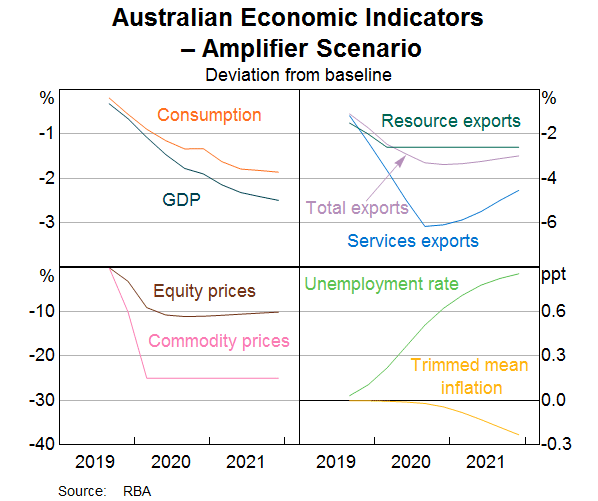
An important caveat to these results is that the financial and banking sector channels in the MARTIN model are fairly limited. Factors such as bank funding costs and interbank liquidity are not captured. As such, it is plausible that greater financial stress could cause the negative effects on the economy described above to be larger.
Shock absorber scenario
In the third scenario, we allow the exchange rate and the cash rate to respond to the effects borne out in the amplifier scenario. In theory, when a negative foreign shock hits the Australian economy, the exchange rate should depreciate, particularly given a decline in the terms of trade. This lowers the relative price of Australian exports making them more internationally competitive, which could facilitate exporters' ability to find new markets at a time of soft Chinese demand. The depreciation also raises the relative price of imports, which puts upward pressure on inflation and encourages consumers and firms to switch their spending to domestic products. As such, we expect the exchange rate would act as a shock absorber, as it has done in the past (Manalo, Perera and Rees 2015). Similarly, monetary policy can respond to a slowdown in economic growth. A lower level of interest rates would support the economy through a depreciation of the exchange rate, raising asset values and by reducing required interest payments on borrowing, freeing up cash for other expenditure.[11]
While Chinese authorities have a stated policy of maintaining currency stability, as discussed earlier, it is conceivable that, in response to a notable shock to activity, policymakers may decide to allow the currency to depreciate to support activity. This would limit the depreciation of Australia's real exchange rate and, as such, some of its influence in counteracting the effects of the slowdown in China.
We consider a hypothetical exchange rate and cash rate profile (illustrated in Graph 13) that together, could largely offset the effects of a decline in overseas economic activity. The lower terms of trade puts downward pressure on the real exchange rate, which responds quickly and declines by around 10 per cent in the first year (Graph 13). The substantially lower exchange rate over the three years provides considerable support to the economy. The cash rate would also be expected to decline, although the pace may be gradual because the central bank makes its decision under uncertainty in relation to the severity of the overseas shock.[12] Furthermore the cash rate decline is relatively small in this scenario given the already considerable support provided by the lower exchange rate. The cash rate would decline by around 25 basis points after a year; this monetary policy accommodation would then be gradually unwound. If the exchange rate did not depreciate by as much, a larger reduction in the cash rate may be warranted. We would still see an initial slowing in growth and rise in unemployment, in line with the amplified China-slowdown scenario (Graph 14). However, the exchange rate and monetary policy movements could offset much of the negative consequences of the slowdown in China over time.
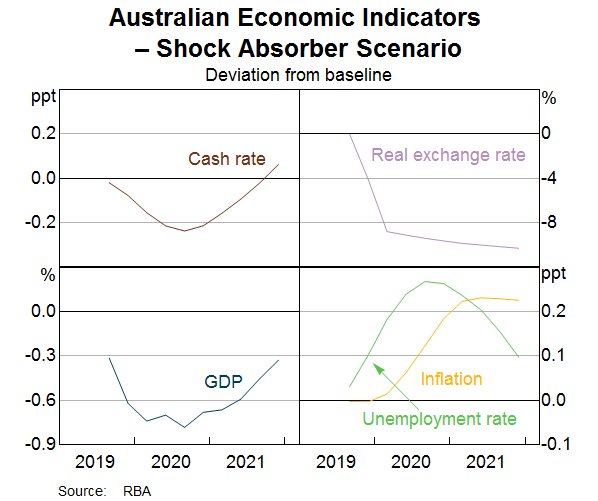

Relative to the case where the cash rate and exchange rate do not adjust, household spending, investment and exports would decline by less. However, they would remain lower for many years relative to what would have occurred without the China slowdown. Import volumes would decline substantially, because the depreciating exchange rate renders overseas goods and services relatively more expensive; this boosts GDP growth. The lower cash rate would also stimulate dwelling investment, which adds a little growth in the latter part of the scenario period. Finally, the effect of the exchange rate depreciation on higher import prices offsets the negative effect of more labour market slack on inflation, leading to a small pick-up in underlying inflation of 0.2 percentage points.
The possibility of a slowdown in China is often highlighted as a key uncertainty for Australia's economic outlook. Overall, the scenarios demonstrate a range of plausible channels through which a foreign shock could affect the domestic economy. We show that a slowdown in Chinese economic activity of around 5 per cent could result in a decline in Australian GDP of up to 2½ per cent, depending on the nature of the scenario. There is potential for the exchange rate and monetary policy to provide some offset to these effects. Of course, additional forces could come into play, which we have not accounted for. For example, Chinese foreign investment into Australia could decline, which would affect dwelling and other investment. However, there has already been a noticeable softening in Chinese foreign investment to low levels, so a further decline may not be material. A Chinese economic downturn could have larger effects internationally – beyond the trade and equity market links we have incorporated – which would have larger negative implications for the Australian economy. On the other hand, automatic stabilisers (lower tax and higher government spending) and discretionary fiscal stimulus can also provide an additional shock absorber for the domestic economy.
Conclusion
The Chinese economy has expanded rapidly over the past few decades and cross-border linkages with Australia have increased. However, since the early 2010s, Chinese growth has eased. This slowing has been orderly and designed to move the economic trajectory onto a more sustainable footing. However, risks remain elevated, particularly in relation to increased indebtedness. There is a broad range of potential triggers for a severe slowdown in the Chinese economy, including a property market slowdown, an external demand shock or a financial system shock. Given Australia's connectedness with China, this could have important consequences for the domestic economy.
Trade linkages and China's influence on global commodity markets are likely to be the key channels through which a slowing in growth in China would spill over to Australia. A sizeable decline in economic activity in China is likely to decrease Australian economic growth, through lower exports and investment, raising unemployment and putting downward pressure on prices. Greater global uncertainty can lead to lower consumer confidence and equity prices, which would amplify the effect of an overseas shock. However, these negative effects can be offset to a degree by an exchange rate depreciation and accommodative monetary policy. While larger effects are possible, especially if the global and financial spillovers from a China-specific shock are greater than what is factored into our scenarios, the effects on the Australian economy will ultimately be contingent on whether policy is able to respond in a way that is sufficiently timely and commensurate to the size of the shock.
Footnotes
The authors are from Economic Analysis Department. [*]
See Li (2019). [1]
See Cusbert and Kendall (2018) for a description of MARTIN. [2]
We take a similar approach to Gilhooly et al (2018) in characterising the mechanisms that underline the scenario analysis. [3]
Discretionary fiscal policy may also be used to counteract the impact of a global slowdown onto Australia. However, we do not include this channel in our analysis. [4]
This is based on estimates using the Oxford Economics Global Economic Model and world input-output tables from the OECD and European Commission. [5]
Movements in the commodity prices are based on Dieppe et al (2018) and are in line with other estimates in the literature. The global interest rate and price movements are based on results from the Oxford Economics model. [6]
This is roughly twice as large as estimates in Zhai and Morgan (2016). Their estimates take into account a large fall in commodity export volumes but a much smaller decline in commodity prices. [7]
This is based on Australia's resources exposure to China (about 40 per cent) and Chinese import elasticity (of around 1.3). However, it is possible that China would support Chinese domestic producers, so the decline in Australian resource export volumes could be larger. [8]
See RBA (2015) for a discussion of how concerns about the prospects for economic growth in China triggered substantial equity market volatility during the second half of 2015. [9]
In the scenario, global interest rates – defined as interest rates in the United States, euro area and Japan – are estimated to decline by around 7 basis points after six quarters, before rising again. The movements in global interest rates are modest, given interest rates in these economies are already low and some have little room to move lower. [10]
See Atkin and La Cava (2017) for a description of the mechanisms through which a lower cash rate can stimulate the economy. [11]
In the model, the cash rate responds to past data and so may seem slow to react. Alternatively, monetary policy could respond faster in anticipation of further slowing in China, which would in turn make the downturn slightly less severe. [12]
References
Atkin T and G La Cava (2017), ‘The Transmission of Monetary Policy: How Does It Work?’, RBA Bulletin, September, pp 1–8.
Australian Treasury (2018), ‘Statement 2: Economic Outlook’, Budget 2017–18, May.
Boulter J (2018), ‘China's Supply-side Structural Reform’, RBA Bulletin, December, viewed 31 May 2019.
Cusbert T and E Kendall (2018), ‘Meet MARTIN, the RBA's New Macroeconomic Model’, RBA Bulletin, March, viewed 31 May 2019.
Dieppe A, R Gilhooly, J Han, I Korhonen and D Lodge (2018), ‘The transition of China to sustainable growth – implications for the global economy and the euro area’, ECB Occasional Paper Series 206.
Eftimoski M and K McLoughlin (2019), ‘Housing Policy and Economic Growth in China’, RBA Bulletin, March, viewed 31 May 2019.
Gilhooly R, J Han, S Lloyd, N Reynolds and D Young (2018), ‘From the Middle Kingdom to the United Kingdom: Spillovers from China’, Bank of England Quarterly Bulletin 2018 Q2.
Li K (2019), ‘Report on the Work of the Government’, State Council of the People's Republic of China, 16 March.
Ma G, I Roberts and G Kelly (2016), ‘A Rebalancing Chinese Economy: Challenges and International Implications’, in I Day and J Simon (eds), Structural Change in China: Implications for Australia and the World, Proceedings of a Conference, Reserve Bank of Australia, Sydney, pp 177–236.
Ma G, I Roberts and G Kelly (2017), ‘Rebalancing China's Economy: Domestic and International Implications’, China & World Economy, 25(1), pp 1–31.
Manalo J, D Perera and D Rees (2015), ‘Exchange Rate Movements and the Australian Economy’, Economic Modelling, 47, pp 53–62.
McCowage M (2018), ‘Trends in China's Capital Account’, RBA Bulletin, June, viewed 31 May 2019.
RBA (Reserve Bank of Australia) (2014), ‘Box B: Iron Ore and Coal Cost Curves’, Statement on Monetary Policy, August.
RBA (2015), ‘The Global Financial Environment’, Financial Stability Review, October, pp 3–15.
RBA (2019), ‘Economic Outlook’, RBA Statement on Monetary Policy, February.
Rickards P (2019), ‘The International Trade in Services’, RBA Bulletin, March, viewed 31 May 2019.
Roberts I, T Saunders, G Spence and N Cassidy (2016), ‘China's Evolving Demand for Commodities’, in I Day and J Simon (eds), Structural Change in China: Implications for Australia and the World, Proceedings of a Conference, Reserve Bank of Australia, Sydney, pp 107–158.
U.S. Energy Information Administration (2018), ‘China surpassed the United States as the world's largest crude oil importer in 2017’, 5 February.
Wang JC and L Berger-Thomson (2015), ‘Consumer Sentiment Surveys’, RBA Bulletin, December, pp 1–8.
Zhai F and P Morgan (2016), ‘Impact of the People's Republic of China's Growth Slowdown on Emerging Asia: A General Equilibrium Analysis’, ADBI Working Paper Series 560.